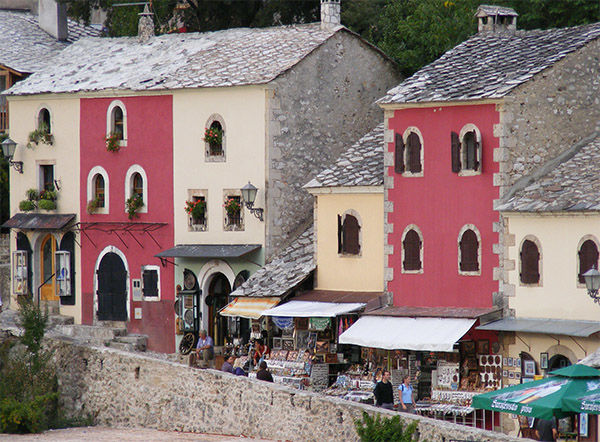Mending Bridges in Mostar
By Rick Steves

The city of Mostar lies at a crossroads of cultures: just inland from the Adriatic coast, in the southern part of Bosnia-Herzegovina. Mostar — where Orthodox Serbs, Catholic Croats, and Muslim Bosniaks had lived in seeming harmony before the war, then suffered horribly when its warring neighborhoods turned the city into a killing zone — provided me with one of the richest experiences of my travel year. The vibrant humanity and the persistent reminders of the terrible war a decade and a half ago combine to make Mostar strangely exhausting.
Before the war, Mostar was famous for its 400-year-old, Turkish-style stone bridge. Its elegant, single-pointed arch was a symbol of Muslim society here, and of the town's status as the place where East met West in Europe. Then, during the 1990s, Mostar became a poster child of the Bosnian war. First, the Croats and Bosniaks forced out the Serbs. Then they turned their guns on each other — staring each other down across a front line that ran through the middle of the city. Across the world, people wept when the pummeled Old Bridge — bombarded by Croat paramilitary artillery shells from the hilltop above — finally collapsed into the river.
Now the bridge has been rebuilt and Mostar is thriving. It happens to be prom night. The kids are out, and Bosnian hormones are bursting. Being young and sexy is a great equalizer. With a beer, loud music, desirability, twinkling stars — and no war — your country's GDP doesn't really matter.
And yet, strolling through teeming streets, it's chilling to think that, just a few years ago, these people — who make me a sandwich, direct me to a computer terminal in the Internet café, stop for me when I cross the street, show off their paintings, and direct the church choir — were killing each other.
Walking past a small cemetery congested with more than a hundred white-marble Muslim tombstones, I notice the dates. Everyone died in 1993, 1994, or 1995. This was a park before 1993. When the war heated up, snipers were a constant concern — they'd pick off anyone they saw walking down the street. Bodies were left for weeks along the main boulevard, which had become the deadly front line. Mostar's cemeteries were too exposed, but this tree-filled park was relatively safe from snipers. People buried their loved ones here…under cover of darkness.
I meet Alen, a thirtysomething Muslim who emigrated to Florida during the war, and is now back home in Mostar. He explains, "In those years, night was the time when we lived. We didn't walk...we ran. And we dressed in black. There was no electricity. If the Croat fighters didn't kill us with their bullets, they killed us with their hateful pop music. It was blasting from the Croat side of town."
Alen points to a tree growing out of a ruined building and says, "It's a strange thing in nature: figs can grow with almost no soil" — seeming to speak as much about the difficult lot of Mostar's people as its vegetation. There are blackened ruins everywhere. When I ask why — after 15 years — the ruins still stand, Alen explains, “Confusion about who owns what. Surviving companies have no money. The bank of Yugoslavia, which held the mortgages, is now gone. No one will invest until it's clear who owns the buildings."
Mostar's skyline is tense with symbols of religious conflict. Ten minarets pierce the sky like proud exclamation points. And, across the river, twice as tall as the tallest minaret, stands the Croats' new Catholic church spire. And from the top of the reconstructed bridge I see, on the hilltop high above the town, a single, bold, and strongly floodlit cross. Alen says, "We Muslims believe that cross marks the spot from where they shelled this bridge…like a celebration."
Leaving Mostar to return to Croatia, I stop at a tiny grocery store, where a woman I befriended the day before — a gorgeous person, sad to be living in a frustrating economy, and unable to bend down because of a piece of shrapnel in her back that doctors decided was safer left in — makes me a hearty ham sandwich. As she slices, I bend down to gather the rest of what will be a fine picnic meal on wheels.
On the way out of town, I drive over patched bomb craters in the pavement. In Sarajevo (the country's capital, which suffered similar strife), they've filled these scars with red concrete as memorials: "Sarajevo roses." Here they are black like the rest of the street — but knowing what they are, they show up red in my mind.

